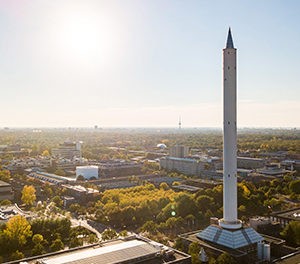Research of the highest caliber

As a university that strives for excellence and reaching new heights, Mines joining the top tier of research universities in the United States earlier this year was just one more way for the university to showcase the innovation and leadership of its faculty, students and graduates.
Recognized by the Carnegie Classification of Institutions of Higher Education, Mines was elevated to the Research (R1) classification, the highest and most prestigious designation granted to U.S. research universities. Only 146 colleges and universities—out of nearly 4,000 public and private higher education institutions nationwide—have this classification.
We sat down with Walter G. Copan, vice president for research and technology transfer at Mines, to learn more about what this classification means for Mines and the innovation happening on campus.
Mines Magazine: Why is Mines’ elevation to R1 status a significant achievement for the university?
Walter Copan: The elevation to R1 is an external recognition that signifies to the world and to our science and technology funding agencies that Mines is a place where research matters—that we have the infrastructure to support research at a very high level and with wide reach. As we attract new faculty, students and research partners, they know they’re working with an institution that’s been independently assessed as having a high-caliber, high-intensity research environment. The stature the R1 designation further amplifies and conveys to our graduate and undergraduate students the value of the education here. It is another justly-deserved accolade for Mines as an amazing, top-tier university.
MM: What does this mean for how Mines engages with our research partners and wider society?
Copan: Members of Congress and leaders in the public and private sectors call upon Mines for our opinions, seeking our viewpoints and expertise on critical issues that face the nation and the economy. As we look to the future of science and technology investment and of innovation and competitiveness for the U.S., Mines has a reputation of being highly credible in conducting impactful research, as well as a place that’s grounded and practical. Industry values the research conducted by Mines, the partnerships with our faculty and the quality of the students we produce. The fact that more than 20 percent of the Mines research volume comes from industry attests to the relevance of our work to the economy. Our reputation in research and academia has worldwide reach, leading to a steady stream of new relationships with governments, academic institutions and corporations around the globe.
So much of what industry needs today is people who are well prepared to lead, think holistically at a systems level and are able to engineer solutions that matter. I’m thrilled at the journey that we’re on as a university to take our relationships with industry to the next level and foster partnerships that also create important new solutions.
MM: What does the future of Mines research look like?
Copan: If we can extrapolate from where Mines has come over the past century and a half, as a university that educates, inspires and innovates, we have a very bright future ahead in our next 150 years. Mines was founded to deliver relevant impacts to society and industry, advancing the leading edge of technologies and educating scientists and engineers uniquely well-prepared to lead. We will build upon those strengths in a broadening research portfolio that is relevant to tomorrow’s economy and to address the challenges facing our planet and civilization.
We don’t know in many cases where today’s science and technology discoveries will lead. We do know we are building upon a tremendous heritage of innovation. We have not forgotten our roots. The name “Mines” persists, and what that means to the world today and for the future has expanded broadly. I think a big part of our role at this university is to be the champions for future possibilities, the researchers and innovators for the earth, energy and the environment. Mines has embraced the roles that science and technology play in society and to ever be partners to industry, academia and to governments here in this nation and around the world—to achieve solutions that matter. I firmly believe that this university has a brilliant future in store.





